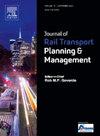铁路货运服务质量与客户满意度之间的关系:结构方程建模方法
IF 2.7
Q3 TRANSPORTATION
Journal of Rail Transport Planning & Management
Pub Date : 2024-10-21
DOI:10.1016/j.jrtpm.2024.100485
引用次数: 0
摘要
推广使用铁路货运可以提高物流绩效,促进可持续发展。要提高铁路货运的份额,关键是要了解其服务质量因素及其与客户满意度之间的关系,而目前尚未对这些因素进行研究。因此,本研究的目标有两个:第一,构建可靠的服务质量测量工具,以了解服务质量因素及其相关指标;第二,研究这些服务质量因素与客户满意度之间的直接和间接关系。对孟加拉国的托运人、货运代理、清关和货运代理(C&F)进行了问卷调查,共收集到 209 个样本。通过探索性因子分析(EFA)和确认性因子分析(CFA)对数据进行分析,我们开发了一个六维度的服务质量测量工具,包括有形性、运输成本、运输时间、可靠性、安全保障和响应性。结构方程模型(SEM)得出的实证结果表明,有形性对客户满意度的影响最大,其次是运输成本。此外,运输时间、可靠性和响应速度对客户满意度的影响也很大。研究结果将有助于铁路部门改善铁路货运的服务质量,从而提高客户满意度。本文章由计算机程序翻译,如有差异,请以英文原文为准。
Relationships between service quality and customer satisfaction in rail freight transportation: A structural equation modeling approach
Promoting the use of rail for freight transportation can improve logistics performance and contribute to sustainable development. To increase the share of rail freight, it is crucial to understand its service quality factors as well as their relationships with customer satisfaction, which have not been studied yet. Therefore, the objective of this study was twofold: first, to construct a reliable service quality measurement instrument for understanding the service quality factors and their associated indicators; and second, to examine the direct and indirect relationships between these service quality factors and customer satisfaction. A questionnaire survey was conducted among shippers, freight forwarders, and clearance and forwarding agents (C&F) in Bangladesh, resulting in the collection of 209 samples. Analyzing the data through exploratory factor analysis (EFA) and confirmatory factor analysis (CFA), we developed a six-dimensional instrument for service quality measurement, which includes tangibility, cost of transportation, transit time, reliability, safety and security, and responsiveness. The empirical results obtained through structural equation modeling (SEM) indicated that tangibility has the highest impact on customer satisfaction, followed by cost of transportation. Additionally, transit time, reliability, and responsiveness also play significant roles in influencing customer satisfaction. The findings of the research would help the rail authorities improve the service quality of rail freight transportation and, consequently, enhance customer satisfaction levels.
求助全文
通过发布文献求助,成功后即可免费获取论文全文。
去求助
来源期刊

Journal of Rail Transport Planning & Management
TRANSPORTATION-
CiteScore
7.10
自引率
8.10%
发文量
41
 求助内容:
求助内容: 应助结果提醒方式:
应助结果提醒方式:


